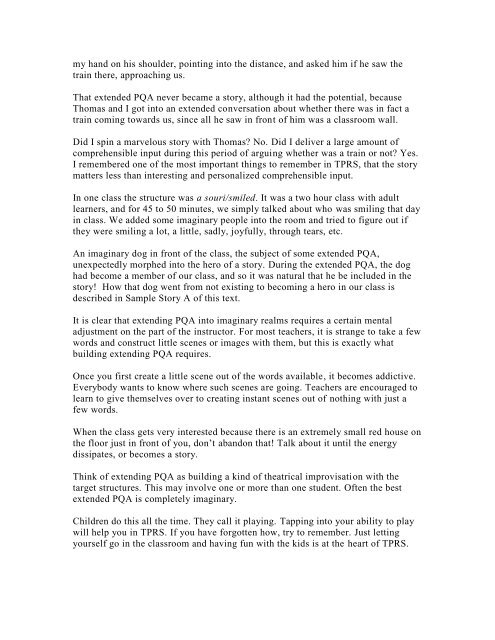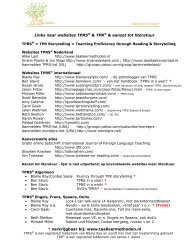TPRS in a Year - Taalleermethoden
TPRS in a Year - Taalleermethoden
TPRS in a Year - Taalleermethoden
Create successful ePaper yourself
Turn your PDF publications into a flip-book with our unique Google optimized e-Paper software.
my hand on his shoulder, po<strong>in</strong>t<strong>in</strong>g <strong>in</strong>to the distance, and asked him if he saw thetra<strong>in</strong> there, approach<strong>in</strong>g us.That extended PQA never became a story, although it had the potential, becauseThomas and I got <strong>in</strong>to an extended conversation about whether there was <strong>in</strong> fact atra<strong>in</strong> com<strong>in</strong>g towards us, s<strong>in</strong>ce all he saw <strong>in</strong> front of him was a classroom wall.Did I sp<strong>in</strong> a marvelous story with Thomas? No. Did I deliver a large amount ofcomprehensible <strong>in</strong>put dur<strong>in</strong>g this period of argu<strong>in</strong>g whether was a tra<strong>in</strong> or not? Yes.I remembered one of the most important th<strong>in</strong>gs to remember <strong>in</strong> <strong>TPRS</strong>, that the storymatters less than <strong>in</strong>terest<strong>in</strong>g and personalized comprehensible <strong>in</strong>put.In one class the structure was a souri/smiled. It was a two hour class with adultlearners, and for 45 to 50 m<strong>in</strong>utes, we simply talked about who was smil<strong>in</strong>g that day<strong>in</strong> class. We added some imag<strong>in</strong>ary people <strong>in</strong>to the room and tried to figure out ifthey were smil<strong>in</strong>g a lot, a little, sadly, joyfully, through tears, etc.An imag<strong>in</strong>ary dog <strong>in</strong> front of the class, the subject of some extended PQA,unexpectedly morphed <strong>in</strong>to the hero of a story. Dur<strong>in</strong>g the extended PQA, the doghad become a member of our class, and so it was natural that he be <strong>in</strong>cluded <strong>in</strong> thestory! How that dog went from not exist<strong>in</strong>g to becom<strong>in</strong>g a hero <strong>in</strong> our class isdescribed <strong>in</strong> Sample Story A of this text.It is clear that extend<strong>in</strong>g PQA <strong>in</strong>to imag<strong>in</strong>ary realms requires a certa<strong>in</strong> mentaladjustment on the part of the <strong>in</strong>structor. For most teachers, it is strange to take a fewwords and construct little scenes or images with them, but this is exactly whatbuild<strong>in</strong>g extend<strong>in</strong>g PQA requires.Once you first create a little scene out of the words available, it becomes addictive.Everybody wants to know where such scenes are go<strong>in</strong>g. Teachers are encouraged tolearn to give themselves over to creat<strong>in</strong>g <strong>in</strong>stant scenes out of noth<strong>in</strong>g with just afew words.When the class gets very <strong>in</strong>terested because there is an extremely small red house onthe floor just <strong>in</strong> front of you, don‟t abandon that! Talk about it until the energydissipates, or becomes a story.Th<strong>in</strong>k of extend<strong>in</strong>g PQA as build<strong>in</strong>g a k<strong>in</strong>d of theatrical improvisation with thetarget structures. This may <strong>in</strong>volve one or more than one student. Often the bestextended PQA is completely imag<strong>in</strong>ary.Children do this all the time. They call it play<strong>in</strong>g. Tapp<strong>in</strong>g <strong>in</strong>to your ability to playwill help you <strong>in</strong> <strong>TPRS</strong>. If you have forgotten how, try to remember. Just lett<strong>in</strong>gyourself go <strong>in</strong> the classroom and hav<strong>in</strong>g fun with the kids is at the heart of <strong>TPRS</strong>.



